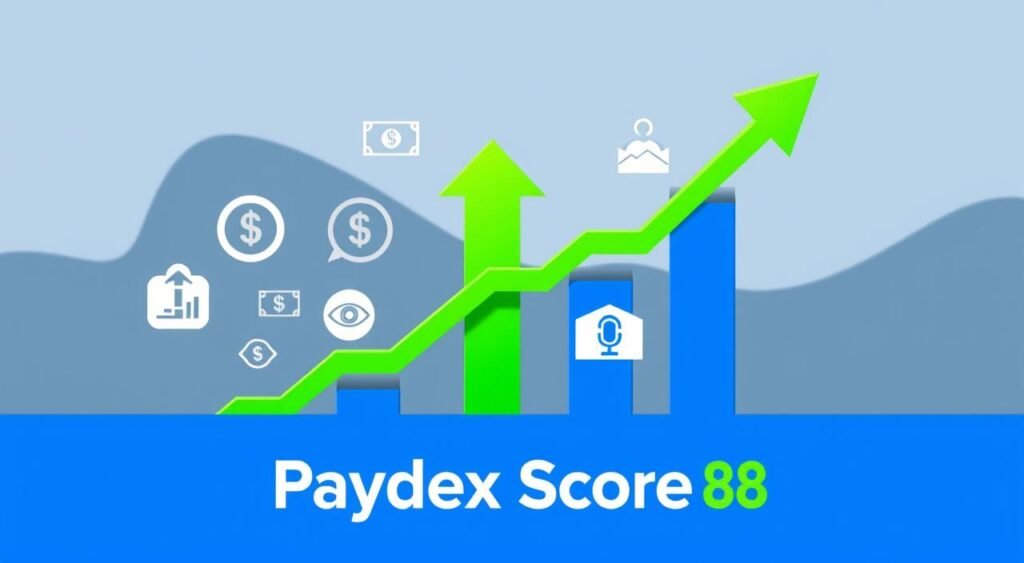Ever wonder how a simple number can make or break your business’s financial future? The PAYDEX score, a pivotal metric in the world of business credit, holds the key to unlocking growth opportunities and financial stability for your company. This powerful tool, ranging from 0 to 100, offers a snapshot of your payment history and creditworthiness to potential lenders and partners1.
As a business owner, understanding and improving your PAYDEX score is crucial for securing favorable financing terms and building strong relationships with suppliers. With scores above 80 indicating early payments and those below signaling potential risks, mastering the art of PAYDEX management can significantly impact your business’s financial health12.
In this guide, we’ll explore practical strategies to boost your PAYDEX score, from timely payments to credit utilization management. You’ll discover how to leverage business credit reports, implement effective credit score management techniques, and unlock the secrets to a stronger financial foundation for your enterprise.
Key Takeaways:
- PAYDEX scores range from 0 to 100, with higher scores indicating better payment history
- Timely payments are crucial for maintaining a good PAYDEX score
- Regular monitoring of business credit reports is essential
- Establishing diverse trade lines can positively impact your score
- Managing credit utilization is key to PAYDEX improvement
- Addressing errors in your credit report promptly is important
- Leveraging business credit building tools can accelerate score growth
Understanding the PAYDEX Score
The PAYDEX Score is a crucial measure of your business’s creditworthiness. It reflects your company’s ability to meet financial obligations and plays a significant role in debt repayment strategies.
What is a PAYDEX Score?
A PAYDEX Score is a 100-point credit score that reflects your business’s payment reliability and financial obligations3. This score, generated by Dun & Bradstreet, ranges from 1 to 100, with higher scores indicating better payment performance4.
How PAYDEX Scores are calculated
PAYDEX Scores are based on your company’s payment history with vendors and suppliers. The calculation considers factors like payment timing and consistency. Early payments can significantly boost your score, making payment history optimization a key strategy for improving your PAYDEX Score.
PAYDEX Score ranges and their meanings
Understanding PAYDEX Score ranges can help you gauge your business’s financial health:
| PAYDEX Score Range | Payment Performance | Risk Level |
|---|---|---|
| 80-100 | Pays early | Low risk |
| 50-79 | Pays on time | Moderate risk |
| 0-49 | Pays late | High risk |
A higher PAYDEX Score reflects better payment performance and lower risk, potentially leading to more favorable terms from suppliers and lenders4. Regular monitoring of your business credit reports is essential to maintain accuracy and address any discrepancies promptly3.
The Importance of a Strong PAYDEX Score

A robust PAYDEX score is vital for your business credit building efforts. This score, ranging from 1 to 100, plays a crucial role in your company’s financial responsibility profile5. Landlords, lenders, and suppliers rely on this score to make important decisions about your business.
With a good PAYDEX score of 80 or above, you’re showing that your business pays bills on time or even early. This punctuality can open doors to better opportunities5. For instance, you might secure more favorable lease terms for business locations or get approved for loans and credit cards with better rates.
Suppliers also use your PAYDEX score to set invoice payment terms. A strong score could lead to more flexible payment options, helping your cash flow management6. Remember, maintaining valuable trade credit relationships and paying vendors on time is key to improving and maintaining a good credit score.
“A strong PAYDEX score is your business’s financial reputation in numbers.”
Your PAYDEX score reflects your business’s creditworthiness in commercial transactions5. It’s dollar-weighted, meaning paying off higher debts has a greater impact. This encourages responsible financial management across all your business dealings.
Building a strong PAYDEX score takes time and consistent effort. You’ll need at least three reported trade experiences from two trade references to start5. For new businesses, establishing a history of commercial debt can speed up this process. Regular monitoring through services like Dun & Bradstreet’s CreditSignal can help you stay on top of your score.
By prioritizing your PAYDEX score, you’re not just improving a number – you’re enhancing your business’s financial standing and opening doors to growth opportunities6. This commitment to financial responsibility can lead to better business credit opportunities and set your company on a path to success.
Timely Payments: The Key to PAYDEX Success
Your PAYDEX score, ranging from 0 to 100, reflects your business’s payment performance. A higher score indicates better payment habits and can open doors to improved financing options78.
The Impact of Early Payments
Early payments significantly boost your PAYDEX score. To achieve a score above 80, pay invoices within the first 30 days after the due date7. This demonstrates excellent vendor relationship maintenance and can enhance your business’s credibility with partners, investors, and clients7.
Strategies for Consistent On-Time Payments
Developing timely payment habits is crucial. Start by obtaining a DUNS number and establishing at least two tradelines with three or more credit experiences8. Consistently pay on time for several months to build a strong payment history and improve your score8.
Setting Up Automated Payment Systems
Implement automated payment systems to ensure you never miss a due date. This approach supports your timely payment habits and helps maintain a high PAYDEX score. Remember, late payments can severely impact your score – payments over 180 days late result in a score of 0, indicating financial distress7.
| Payment Timing | PAYDEX Score | Rating |
|---|---|---|
| Within 30 days of due date | 80-100 | Excellent |
| 31-60 days after due date | 70 | Good |
| 61-90 days late | 50 | Fair |
| 91-120 days late | 40 | Poor |
By prioritizing timely payments and maintaining strong vendor relationships, you can achieve a high PAYDEX score. This can lead to better financing options and improved terms with suppliers, ultimately benefiting your business’s financial health8.
Monitoring Your Business Credit Reports
Keeping a close eye on your business credit reports is crucial for maintaining a strong PAYDEX score. Regular credit monitoring allows you to spot errors, detect fraud, and make informed decisions about your company’s financial health9.

To stay on top of your credit status, you can access your current score for free through D&B’s CreditSignal program. This service provides a 14-day trial period, after which a monthly subscription is required for continued access. Alternatively, third-party sites like Nav offer credit monitoring services that can help you track your business credit reports efficiently.
Understanding the range of business credit scores is essential. While personal FICO scores range from 300 to 850, business credit scores typically span from 0 to 100. A good business credit score is generally considered 76 or higher for Equifax and Experian, and 80 or above for Dun & Bradstreet910.
| Credit Bureau | Score Range | Good Score |
|---|---|---|
| Dun & Bradstreet | 1-100 | 80-100 |
| Equifax | 1-100 | 76-100 |
| Experian | 1-100 | 76-100 |
By diligently monitoring your business credit reports, you can address any discrepancies promptly and take steps to improve your scores. This proactive approach can help you avoid unnecessary scrutiny and increase your chances of obtaining better financing terms in the future9.
Establishing and Maintaining Trade Lines
Building a strong credit profile is crucial for your business success. Trade lines play a pivotal role in establishing your business credit history and influencing lenders and vendors11. Let’s explore how to effectively manage these essential components of credit score management.
Working with suppliers and vendors
Collaborate closely with your suppliers and vendors to ensure they report positive payment experiences to credit bureaus. This practice demonstrates your reliability in meeting financial obligations11. Timely vendor repayments enhance your business’s creditworthiness, showcasing fiscal responsibility11.
Reporting positive payment experiences
Take proactive steps to report your positive payment experiences. Approximately 250,000 small business owners have built business credit history using services like Nav Prime12. Consider using credit-building packages offered by Dun & Bradstreet to submit payment information if your suppliers don’t report payments.
Diversifying your trade references
A diverse portfolio of tradelines strengthens your financial standing. Aim to engage with at least three tradelines to bolster your credit profile11. This variety can include secured credit lines, vendor lines, and retail credit accounts11.
| Tradeline Type | Description | Impact on Credit |
|---|---|---|
| Bank Loans | Traditional financing options | Demonstrates ability to manage larger debts |
| Credit Cards | Revolving credit lines | Shows regular payment habits |
| Vendor Accounts | Trade credit with suppliers | Indicates industry-specific reliability |
| Utility Accounts | Regular service payments | Reflects consistent financial responsibility |
| Lease Agreements | Property or equipment leases | Shows long-term financial commitment |
Remember, the D&B Paydex scoring model requires at least two tradelines and three trade experiences for a business to be scorable13. By diversifying your trade references and maintaining responsible credit management, you’re setting the foundation for a robust business credit profile and improved vendor relationship maintenance.

Managing Credit Utilization for PAYDEX Improvement
Your credit utilization ratio plays a crucial role in your PAYDEX score. This ratio reflects your financial responsibility and impacts your business creditworthiness. Experts recommend keeping your credit usage below 20% to 25% to maintain a healthy PAYDEX score14.
To improve your PAYDEX score, focus on lowering your credit utilization. Pay off credit card balances regularly and consider requesting credit limit increases from your current card issuers15. These actions can help reduce your utilization ratio and boost your score over time.
Businesses with the highest credit scores typically use less than 10% of their available credit14. Aim for this target to maximize your PAYDEX score. Remember, a good PAYDEX score is considered 80 or higher, indicating prompt payment practices16.
Diversify your credit mix by adding a business credit card. This strategy can account for about 10% of your credit score and provide additional flexibility in managing your credit utilization15. By implementing these practices, you’ll demonstrate financial responsibility and improve your chances of securing favorable business financing terms.
Keep in mind that high debt utilization can signal increased financial risks to lenders and investors. It may lead to lower credit ratings and higher financing costs14. By maintaining a low credit utilization ratio, you’re not only improving your PAYDEX score but also positioning your business for long-term financial success.
Addressing Errors and Discrepancies in Your PAYDEX Score
Keeping your PAYDEX score accurate is crucial for maintaining healthy business credit reports. Regular credit monitoring helps catch and fix errors that could harm your score.
How to dispute inaccuracies
If you spot mistakes in your business credit reports, act quickly. Contact the credit bureau directly to dispute any inaccuracies. Provide clear evidence to support your claim, such as payment receipts or bank statements.
Working with Dun & Bradstreet to resolve issues
D&B, one of the three main business credit bureaus, offers a specific process for addressing PAYDEX score issues17. Reach out to their customer service team and clearly explain the problem. Be prepared to provide documentation that proves your case.
Regular credit report reviews
Make it a habit to review your business credit reports frequently. This practice helps you catch errors early and maintain an accurate PAYDEX score18. Remember, your payment history is the most significant factor in calculating your business credit score, so ensure all payments are correctly reported.
By staying vigilant and addressing discrepancies promptly, you can maintain a strong PAYDEX score. This, in turn, can lead to better loan terms, lower insurance premiums, and improved business growth opportunities19.
Leveraging Business Credit Building Tools
Business credit building tools are essential for improving your PAYDEX Score and managing your credit effectively. These tools offer invaluable resources for establishing and maintaining a robust credit profile, especially crucial for businesses whose suppliers don’t regularly report payment information to credit bureaus.
Dun & Bradstreet provides credit-building packages like CreditBuilder Plus and CreditBuilder Premium. These tools allow you to proactively submit payment information, helping you build a strong credit foundation. By using these services, you can take control of your business credit profile and potentially improve your chances of loan approval20.
Credit monitoring services are another vital tool in your arsenal. They help you track changes in your business credit score and alert you to potential issues. This proactive approach to credit score management can prevent small problems from becoming major obstacles.
Business credit cards are powerful tools for building credit. They typically report to business credit bureaus and can help establish an excellent business credit rating. Plus, they offer benefits like cash back ranging from 1-5% of purchases, travel rewards, and vendor discounts21.
| Tool | Purpose | Benefits |
|---|---|---|
| CreditBuilder Packages | Proactive credit building | Submit payment info, establish credit profile |
| Credit Monitoring Services | Track credit changes | Early problem detection, score improvement |
| Business Credit Cards | Build credit history | Rewards, discounts, separate business credit |
Remember, payment history is crucial for building business credit. Even a few days late payment can be reported on business credit accounts, so always strive to pay on time or early20. By leveraging these tools effectively, you can take significant strides in improving your business credit profile and unlocking better financial opportunities for your company.
Conclusion
Improving your PAYDEX score is a vital step in strengthening your business’s financial health. By understanding how credit reporting agencies like Experian, Equifax, and Dun & Bradstreet evaluate your business, you can take targeted actions to boost your score2223.
Remember, timely payments are crucial. Aim for a PAYDEX score of 80 or above, which reflects excellent payment performance22. Regularly review your business credit reports for accuracy, as they contain key information like your legal name, registered address, and payment history2224.
To improve your PAYDEX score, focus on paying creditors and suppliers on time, disputing any errors in your credit report, and managing UCC filings24. Consider consulting with an accountant to review your credit portfolio and devise strategies for improvement. By taking these steps, you’ll not only enhance your PAYDEX score but also open doors to better financing options and business growth opportunities.
Keep in mind that while personal credit may influence business credit card approvals, using a business credit card responsibly can help build your business credit23. Stay proactive in monitoring your business credit reports, especially before applying for loans or credit, to ensure you’re presenting the best possible financial picture to potential lenders and partners.
FAQ
What is a PAYDEX Score?
How is the PAYDEX Score calculated?
Why is a strong PAYDEX Score important for businesses?
What is the most effective way to improve your PAYDEX Score?
How can businesses monitor their PAYDEX Score?
How can businesses establish and maintain trade lines?
How does credit utilization impact PAYDEX Scores?
How can businesses address errors and discrepancies in their PAYDEX Score?
What business credit building tools can help improve PAYDEX Scores?
Source Links
- PAYDEX Score: The Only Ultimate Guide You Need To Read – https://www.forbes.com/advisor/credit-score/paydex-score/
- 5 Ways to Improve Your Business Credit Score – https://www.linkedin.com/pulse/5-ways-improve-your-business-credit-score-armando-armendariz
- Understanding the Three Major Business Credit Bureaus – https://www.score.org/resource/article/understanding-three-major-business-credit-bureaus
- Understanding Business Credit Scores – Credit Strong – https://www.creditstrong.com/business/business-credit-scores/
- Understanding the Paydex Score – https://www.businessinsider.com/personal-finance/credit-score/what-is-paydex-score
- What Is a Good Business Credit Score? | Nav – https://www.nav.com/resource/what-is-a-good-business-credit-score/
- Paydex Scores: Your Key to Small Business Financial Success. – https://www.paycron.com/blog/unlocking-financial-success-a-comprehensive-guide-to-paydex-scores-for-small-businesses
- PAYDEX Score: The Dun & Bradstreet Business Credit Rating – https://ramp.com/blog/what-is-a-paydex-score
- Business Credit Scores and Reports | Nav – https://www.nav.com/business-credit-scores/
- How to check your business credit – https://www.creditkarma.com/advice/i/how-to-check-business-credit
- Business Tradelines: 5 Best Steps To Boost Credit – https://sunwisecapital.com/business-tradelines-to-build-your-credit/
- Business Tradelines and How they Affect Your Credit Score | Nav – https://www.nav.com/resource/business-tradelines/
- Business Tradelines That Build Your Business Credit – Credit Strong – https://www.creditstrong.com/business-tradelines/
- How Debt Utilization Affects Business Credit Scores | Nav – https://www.nav.com/resource/debt-utilization-credit-scores/
- Strategies to Improve Your Business Credit Score – https://newfrontierfunding.com/strategies-improve-business-credit-score/
- PAYDEX® Business Credit Score Guide – Huddle Business Capital – https://huddlebc.com/blog/paydex-score-guide
- How to Repair Business Credit | eCredable – https://business.ecredable.com/resources/blog/repair-business-credit
- Understanding Your Business Credit Score: A Simple Guide – https://www.linkedin.com/pulse/understanding-your-business-credit-score-simple-6hppe
- Business Credit Score: Unlock New Growth Opportunities – https://loanbud.com/business-credit-score-unlock-new-growth-opportunities/
- Leverage Credit to Grow Your Business | Nav – https://www.nav.com/blog/leverage-business-credit-to-grow-32511/
- Small Business Credit Cards to Build Your Business | Pursuit – https://pursuitlending.com/resources/small-business-credit-cards/
- Business Credit Reports: How to Check and Interpret Them – https://www.highradius.com/resources/Blog/guide-to-business-credit-report/
- Business Credit Reports: What They Are, How to Check Yours – NerdWallet – https://www.nerdwallet.com/article/small-business/business-credit-report
- Understanding Business Credit Reports – – https://www.ryanandwetmore.com/insights/rwblog/understanding-business-credit-reports

